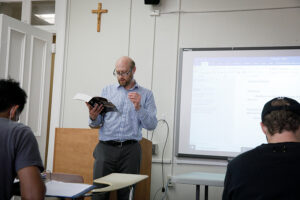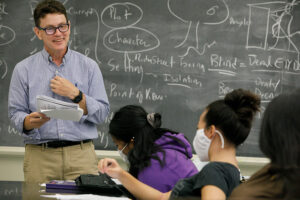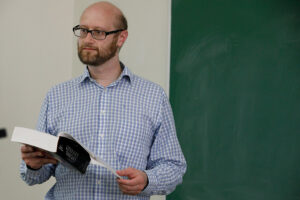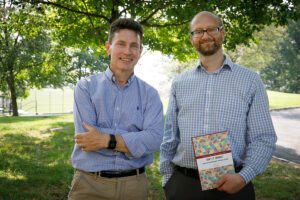Using Satire in the Classroom
10/20/2021
How Two Professors Used Their Students’ Submissions to Get Published*
*Don’t worry, this is the Office of Public Relations’ feeble attempt at sarcasm—Professors Jacklosky and Leporati would never. They are exceptional, plus they fully collaborated with their students for their research and this publishing experience.
Rob Jackolsy, Ph.D., Professor of English and Matthew Leporati, Ph.D., Assistant Professor of English wrote a chapter called “Peeling The Onion: Pop Culture Satire in the Writing Classroom” in a collection that appears in Isn’t It Ironic? Irony and Popular Culture. The chapter is based on their use of satire in teaching the Mount’s ENGL 203 Writing Workshop, an advanced composition course offered every spring for select freshmen who are nominated by their ENGL 110 Writing in Context I instructors—as well as some upperclassmen who are English majors or writing minors.
The chapter explores theory and the practice of bringing satire into the classroom, and even includes an exercise led by our two extraordinary professors where students composed their own satirical pieces—so, it’s no surprise the article includes some of those creative, divergent-thinking excerpts.
Let’s get to the bottom of how the two professors used their teaching acumen to incorporate satire into the classroom, helping their students improve as writers, grow as thinkers and citizens, and even be published.
Why did you decide to use satire in ENGL 203 Writing Workshop and how do you integrate it in the course?
Matthew Leporati [ML]: ENGL 203 starts with a unit on tone in writing and I realized in the process of teaching the course that I needed to give more attention to satire, which is an important rhetorical mode that utilizes tone—and it is one that students generally don’t have a firm grasp on. As we discuss in the article, students often don’t “get” satire when we introduce it. I’ve brought articles from The Onion to class and a lot of times students don’t realize the target of the joke or how the humor is operating in the piece.
After the unit on tone, we have our classes study Jonathan Swift’s classic satirical text A Modest Proposal, which famously addresses the problem of Irish poverty by proposing selling the babies of impoverished families as food. Once we examine the techniques that Swift uses, we bring in satirical articles from pop culture sources and examine how they use those similar techniques to criticize contemporary injustices. Finally, we lead our students through a series of exercises to produce their own satirical texts.
How are students selected to take ENGL 203?
[ML]: ENGL 203 is an advanced composition course that is mostly for first-year writers who have been recommended by their ENGL 110 instructor. Freshmen who are recommended for the course may choose to take it as a substitute for the ENGL 120 [Writing in Context II] requirement. Sometimes, writing minors or English majors who need an additional three credits will take the class at the discretion of the instructor, but functionally it’s a more advanced 120 class intended primarily for freshmen.
Robert Jacklosky [RJ]: Yes, these are usually gifted students in ENGL 203, either identified by their ENGL 110 instructors or English majors/minors. But they are usually very good at traditional academic critical essays that you’d write in ENGL 110. There is still a reluctance to take a “risk” on writing original material since the way they got to ENGL 203 was writing critical essays that habitually got As. So, you have to coax them in a different way than a student who gets Bs or Cs in traditional academic writing and who’s eager to do something different.
What does the exercise where you guide students in composing their own satirical pieces look like?
[RJ]: As a first step, Matthew has this in-class prompt he borrowed from one of his mentors where the students read a traditional fable “The Princess and the Pea” and then they randomly pick from a set characters with comic potential—”a jealous half-sister of princess” or the prince’s “the fraternity brother”—and write the same story from that point of view and tone. It tends to loosen them up and when they read them out loud for the class, they get lots of positive feedback. I have them do all the writing in class so they have the excuse and pressure of “not much time” and I think that gives them confidence and sets the table for the Johnathan Swift satire which is more ambitious. They get to work on that at home over the usual revision cycle.
We then read with them a lot contemporary satire. Matthew tends to use The Onion and I tend to use McSweeney’s Internet Tendency and “Shouts & Murmurs” from The New Yorker. All these show them that satire can be about their own concerns (being angry about something really helps satire) ranging from terrible boyfriends to highway driving, to men who catcall at them in the streets. I have my own comic pieces in McSweeney’s that I mostly don’t alert them to because they aren’t useful models for satire that once in a while, if I’m feeling comfortable with a group, I’ll point out to them. And I think they are amazed that a person could be a professor and write moderately funny things. Since, for them, academics are often defined as the opposite of fun. Historically, when you introduce a satire as funny in a classroom, it automatically is not funny because it’s in a classroom. That says something about the disconnect between academics and enjoyment, and making yourself vulnerable in writing comedy that having them write their own satires tends to highlight. When they write their own funny thing in a classroom, they have to admit it’s possible to have fun in a classroom.
Why is satire important in the writing workshop and how does it make students better writers?
[ML]: We argue in the chapter that being able to grasp and compose satire requires readers and writers to have a nuanced understanding of audience, tone, and argument. Mastering satire requires students to develop abilities that make them more persuasive writers in general, more nuanced thinkers, and even more ethical citizens who have more rhetorical tools to attack injustice through humor.
[RJ]: For years, I’ve been giving students a “creative option” in my comedy classes. Instead of writing a critical analysis of a short story or play, they could write an original in “the style of”—which is in some ways much harder—to capture the structure, tone, or angle that makes a piece work. It also works a different set of muscles that students might not get a chance to show off in ordinary assignments. For instance, a student who was getting Cs in critical analysis papers wrote a piece of pure comedy and got an A—and was amazed. But as I told him, it was better writing because he felt “freed up” and he found his exuberance and voice that was constrained by traditional assignments. And that confidence can carry over into their academic writing.
Matthew and I would talk about comedy pieces in our respective classes, and how hard it was to get students (especially the current generation that wasn’t brought up on irony and satire, like we were with SNL, Second City TV, Monty Python, and National Lampoon) to hear tone in various pieces. You could describe it or tell them why it was a certain tone and therefore funny, but explaining comedy famously doesn’t work. These exercises allow them to walk past that barrier and get “inside.” They find they can do it even if they can’t at first hear it in other, older pieces that may have lost their comic zing over time.
Finally, I’d say writing about something you’re passionate about or angry at sharpens the writing, makes it more specific and cohesive. And that carries back over into the academic writing. Students are often told to be dispassionate and analytical—which obviously has its place—but it can sap the energy of a piece.
Why did you decide to have a chapter published on the topic and how did you choose the publication?
[ML]: I saw a call for papers soliciting chapters for a book about irony in popular culture. I saw this call right around the time I was planning a lesson on satire, and I realized that what Rob and I were doing with our classes—using articles from The Onion and other popular forms of satire in the classroom—fit this publication nicely. Rob and I developed a proposal for a chapter and it was enthusiastically received.
Why do you believe it is important for the young writers in your classrooms that your chapter about satire and their writing were featured in this publication?
[ML]: We both strongly believe that teaching and scholarship inform each other. What we do in the classroom is an important part of how we develop our scholarly publications, and we publish not only to share our insights with other academics but to hone our teaching even further. Our chapter ends with some ideas for how we might further develop these lessons in future classes, and it’s our hope that those who read our chapter will be inspired to incorporate satire more fully into their own classrooms.
I think it’s important for our students to understand that what we do in the classroom isn’t isolated from the rest of the universe. We deal with important topical issues in class and the work we do in class also feeds into a participation in a broader scholarly conversation in academic publications.
Our chapter features some of the satirical pieces written by students, whom we acknowledge by name, and that’s a very concrete way our students can see themselves as participating in a broader academic discourse.
[RJ]: I was really attracted to this idea of using the actual student writing that came out of our classrooms. The students were so excited to learn that excerpts from their pieces written for and sometimes in the class were going to appear in a book with their names attached. It was immensely gratifying for us to give them that opportunity and exposure since these were very funny pieces.
Can you describe the origins of the chapter and talk about the writing process?
[ML]: The chapter grew organically out of our teaching and collaboration. Rob and I have had many conversations about teaching tone and satire, and we had observed privately how students often don’t “get” it. When the opportunity arose to write about it and describe what we were doing in class, it sharpened what we were doing in class, and our work in the classroom sharpened our writing about it.
I see scholarly writing—much like I’m always telling students about their own academic writing—as a product of community and collaboration. Our chapter is the product of many conversations and emails and drafts—many, many drafts—going back and forth, adding things and taking things out, playing around with different ways of phrasing.
In short, the process of writing this chapter was like a version of what we encourage our students to do: prewrite, draft, revise, edit, revise. That’s the great thing about teaching writing: we get to practice what we teach. And that process enriches the classroom and the world outside the classroom as well.
[RJ]: I want to pay Matthew a compliment here so I hope he doesn’t blush. He is an ideal collaborator: smart, generous, patient and keen-eyed. It helped that we began on the same page about this, and the same philosophy—that our students often produced astonishing work if they were allowed to get inside of satire and find their voices. But our own process of writing and trading those many drafts for me was a pure pleasure. I could see what Matthew was doing and made my contributions. I have to point out this is not always the case with writing collaborations which can be painful. I think we—more than once—called the process “seamless.” Even the students’ work seemed to slot in naturally, completing our arguments and confirming our hypothesis.
About the Chapter
This chapter examines the ways in which ironic popular culture texts can be incorporated into the college writing and literature classrooms in order to help students develop into more rigorous thinkers and writers. As college instructors of basic and advanced writing, we have observed that our students struggle with irony and satire. Although satire seems more prevalent than ever in a ‘post-truth’ world awash with online ‘trolls,’ young people today curiously appear to have more difficulty navigating this rhetorical mode, not less. Our chapter proposes that students’ difficulties in parsing satirical texts not only reveal insights about the contemporary political climate, they also reflect a difficulty among students in grappling with nuance. Incorporating satire more fully into the classroom can help students both improve as writers and grow as thinkers and citizens. This chapter seeks to extend the insights of recent discussions of satire by stressing how teaching this rhetorical mode through popular culture texts offers opportunities for students to hone their abilities to parse and make logical arguments. We first draw upon class discussions with our respective students to reach tentative conclusions about the sources of resistance against satire. We then examine classroom strategies and assignments that help students engage with the rhetorical mode, using popular culture texts as models. We argue that training students in the skills needed to understand satire aids them in becoming more precise thinkers, appreciators of nuance in logical argument, and citizens increasingly resistant to social pressures to self-censor or to abandon sincerity altogether.
About the University of Mount Saint Vincent
Founded in 1847 by the Sisters of Charity, the University of Mount Saint Vincent offers nationally recognized liberal arts education and a select array of professional fields of study on a landmark campus overlooking the Hudson River. Committed to the education of the whole person, and enriched by the unparalleled cultural, educational, and career opportunities of New York City, the College equips students with the knowledge, skills, and experiences necessary for lives of achievement, professional accomplishment and leadership in the 21st century.






